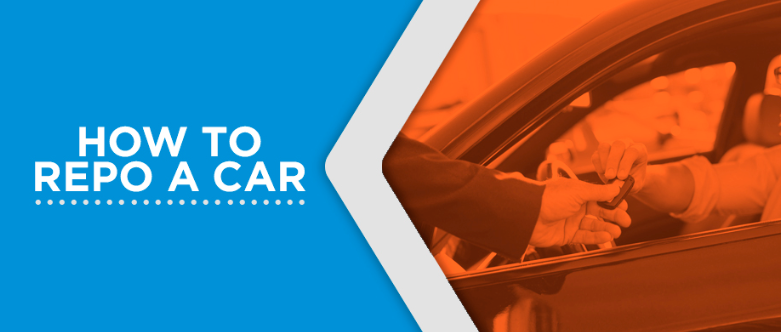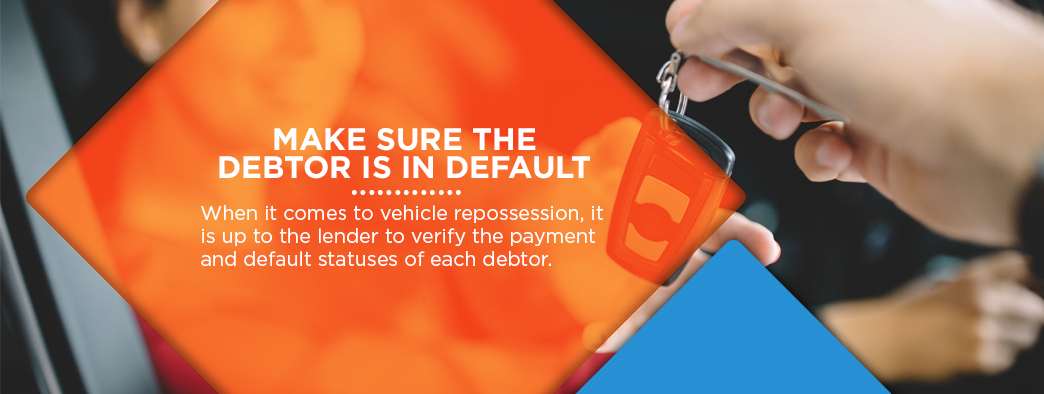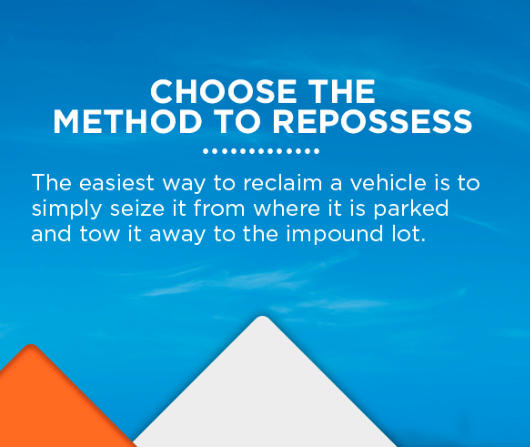
If you want to become a repo agent, you will first need to determine whether you have the right kind of personality for the tasks that the job entails. It takes tremendous amounts of courage and a hefty backbone to carry out vehicle repossessions, as you perform a service in which there is usually going to be a disgruntled party. The steps in car repossession are not complicated, but they involve more than simply going out to reclaim an unpaid vehicle.
Table of Contents
As a repo agent, you will need to have a willingness to walk onto people’s driveways and gain access to vehicles. Often, this will occur right under the nose of the debtor, who might be inside sleeping, eating, showering or watching TV while the recovery takes place. In some of the easier cases, you will simply be able to mount the vehicle onto your wheel lift in a wide, clear driveway and drive off to the impound lot, all in a matter of seconds. However, not all cases are that easy, and you will often need to resort to more guerilla tactics to seize the vehicle.
In cases where the vehicle is difficult to locate or access, you will need to be persistent in tracking all possible leads. For example, you might have to scan the vicinity of a debtor’s place of work if trips to the person’s home address prove fruitless. If that fails to turn up the vehicle, you might have to scan nearby public parking spaces and mall lots. Once you locate the vehicle, it might be angled in a tight spot or sandwiched between other vehicles, and you will need to have methods to extract the car.
How to Repo a Car?
Repossessing a vehicle involves a few steps to make sure you have the right person, car and method so the tow truck driver doesn’t get in legal trouble.
- Know the laws of your state
- Make sure the debtor is in default
- Locate and verify the car
- Choose a method to repossess
1. Know the Repo Laws of Your State
The first thing to know about how to repo a car is you need to be aware of how repo laws stand within the jurisdictions where you will conduct business. While some lenders will be knowledgeable about local repossession laws, others won’t know the legal limits. Don’t take jobs that could put yourself on the wrong side of the law. For example, if a lender want to hire you to repossess a vehicle “by any means necessary” and offers to pay you extra depending on the lengths you go to procure the car in question, politely turn the offer down, as you are likely dealing with a rogue lender.
To gain a full understanding of your authority and limits as a repo agent, meet with a local legal representative to discuss how repo laws work in your state. This way, you will know exactly what measures you can legally take in any given situation, even the more difficult cases where the debtor attempts to hide the vehicle. For example, some states prohibit repo agents from entering garages to seize vehicles while other states allow you to enter regardless of whether the debtor knows of your presence. In some jurisdictions, you can even use unlocking instruments to raise a locked garage door and access the vehicle.
Before you purchase a tow truck or equip your pickup with a lifting/towing device, check with your local DMV to make sure that your driver’s license permits you to operate such vehicles. In most states, you will need to have a Class C license or higher to operate a towing vehicle.
2. Make Sure the Debtor Is in Default
When it comes to vehicle repossession, it is up to the lender to verify the payment and default statuses of each debtor. While a lender can legally initiate repossession proceedings the moment a driver goes into default on a vehicle, most lenders will prioritize a debtor once the person in question has defaulted for the second or third time. A car repossession list will usually feature debtors who are several months behind on payments and who have failed to communicate with the lender since going into default.
The lender will have a file of paperwork on the vehicle, the debtor, the date of the transaction and the balance paid prior to going into default. Therefore, when a lender assigns you the task of reclaiming a car, the only information you should need is the make, model, license plate and identification numbers of the vehicle and the home and work addresses where the vehicle can be found. Granted, you should always see the pertinent documents with your own two eyes and have copies of key information on hand when you go to seize the vehicle.
While it is the lender’s responsibility to know each case and correctly direct you to each outstanding vehicle, you should always be completely certain that your target is the correct one. If you carry out a wrongful repossession based on incorrect information, you could be subject to a lawsuit alongside the lender.

3. Locate and Verify the Car
To find and seize an unpaid vehicle, you will first need to know which places the debtor can be found. In most cases, the lender should be able to provide all the information that you would normally need to locate a vehicle, starting with the debtor’s address. Once the lender has contacted the debtor, and they have exhausted the typical paths to resolve the matter, you will have the legal go-ahead to proceed with the act of repossession.
In the easiest cases, the defaulted-on car will be parked in plain sight in the debtor’s driveway. If such is the case, you can simply tow away the vehicle right then and there and return it to the lender. Alternately, you could enter the vehicle with a secondary key and drive it to the impound lot. In some cases, the lender will provide you with a second key to the vehicle. You might be authorized to unlock the car with a metal wedge or rod and then hotwire the car and drive off.
In most states, it is legal to walk onto a debtor’s property to seize a defaulted-on vehicle. In some states, you can even enter a debtor’s garage without asking to repossess a vehicle. However, other states might define the latter act as “breaching the peace,” so read up on state and local repo laws before you resort to such aggressive tactics.
If the debtor keeps the car parked inside a locked garage at all times when they are neither out to work or doing errands, the task of repossession could be considerably more complicated, especially if you never manage to catch the debtor coming or going from the house. Then again, the car might not be parked inside that closed garage. Instead, the debtor might keep the car parked at a reasonable distance from the house, knowing you are on the case and assuming you will only scan the immediate area.
If you never manage to spot the vehicle on the debtor’s property, scan all the streets within a three-to-five block radius of the subject’s address. In some cases, the debtor will park the vehicle afar to throw off repossession agents yet still keep it within a reasonable walking distance for daily access.
If you cannot seem to locate the vehicle on or near the debtor’s property, scan the parking lots of nearby malls and supermarkets. If a parking lot has loose policies regarding vehicles parked overnight, a debtor might take advantage of this option to evade repossession. Also, scan the streets and parking lots near the debtor’s place of work. In some cases, you might never see the vehicle on the debtor’s property, yet immediately spot the car in the clear light of day outside the subject’s office building.
Some newer vehicles contain tracking technology that makes it easier to locate the car in the event of a theft or payment default. Many of today’s lenders now require that their cars be equipped with such technology, both on the lot and while in the customer’s hands until the payments are completed in full. This is especially the case with luxury cars and other vehicles of high value. With tracking technology, you can generally isolate in the location of the vehicle in question, even if it is parked off-road in an area of dense vegetation.
4. Choose the Method to Repossess
The easiest way to reclaim a vehicle is to simply seize it from where it is parked and tow it away to the impound lot. When it comes to towing capabilities, you have two basic options — purchase a vehicle specially designed for towing or attach a towing device to a passenger pickup truck. The former option will generally require a huge investment on your part and should be reserved until after you have established a thriving business as a repo agent. When you are just starting out, the easier option is to simply equip your truck with a towing attachment.
Aside from towing, the other way to seize a vehicle is to enter it with a secondary key or some alternate unlocking device and then drive the car off to the impound lot. Sometimes, the lender will provide you with a duplicate key to enter the vehicle and start the engine. If the lender is unable to furnish a key, you will need to use a metal wedge or some other alternate unlocking device. If you resort to this latter option, you will also need to know how to hotwire the car in question.
Before entering the vehicle, check through the window to see whether the wheel is equipped with an anti-theft security device. In that case, you will need to have tools on hand to remove the device and seize the vehicle. You will also need to have a contingency in place if the vehicle is equipped with a loud alarm system.

Once you have been given the go-ahead to repossess a vehicle, you may do so with or without the debtor’s knowledge. The debtor will have already received a letter stating that their vehicle payments are in default and that the vehicle will be subject to a seizure if no payments or negotiations are made before a specific date. By the time the lender gets you involved, it will most likely be a case where the debtor cannot be reasoned with in any formal sense.
Depending on your own interpersonal skills and comfort level, you might feel confident approaching some debtors when such opportunities arise and plainly state that you are there to take the vehicle. Always do so with caution. If the subject appears to pose no physical threat and you see the person exit the vehicle in their driveway, you might feel compelled to approach the individual and identify yourself as a repossession agent who has been sent to reclaim the defaulted-on vehicle.
Granted, there is no guarantee that such a walk-up will be kindly received by the party in question, and you are not required by law to take this soft approach. In most if not all cases, you will probably find it easier and more preferable to simply recover the vehicle in that lucky moment when the coast is clear.
5. Do Not Breach the Peace
When you close in on a vehicle, it is crucial to keep your actions within the bounds of the law in your jurisdiction. A vehicle can only be seized through peaceful means that do not damage property or disrupt the delinquent party. As such, any acts involving intimidation or force are out of the question.
Acts that could be defined as “breaching the peace” can vary by state and county. In some areas, entering an open garage to seize a vehicle could be construed as a breach of the peace. In other areas, you would need to jump a fence or jimmy a locked garage to cross the legal line. You could also be prohibited from approaching the debtor’s property to seize the vehicle if the person lives in a gated community where entrance is granted by permission only.
If a debtor spots you in the act of taking a vehicle and demands that you halt the seizure, the law will generally be on that person’s side for the time being, pending subsequent negotiations between the debtor and lender and any further actions the lender takes. Often, a halted repossession will simply result in further punitive actions against the debtor, such a replevin or lien, unless the debtor immediately pays the remaining balance on the vehicle.
Make the Repo Go Smoothly With Lift and Tow Equipment
Once you fully grasp the steps of repossession and have the proper license, your next step is to equip your truck with a towing device. At Lift and Tow, we sell a range of lifting devices that can turn your pickup into a towing truck, suitable for repossessing cars of various sizes. Contact Lift and Tow today to learn more about our equipment and how it can help you succeed as a repo agent.